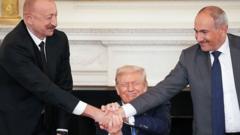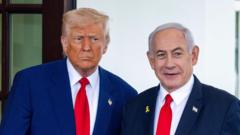Amid rising trade tensions, the US and China have agreed to extend their tariff truce deadline by 90 days, enabling further negotiations and preventing imminent tariff increases.
US and China Trade Truce Extended, Eases Tariff Concerns

US and China Trade Truce Extended, Eases Tariff Concerns
New deadline pushes potential tariff hike back, aiming for bilateral trade stability
The United States and China have decided to extend their trade truce, pushing the deadline back by 90 days just hours before a planned increase in tariffs was set to take effect. This extension, prompted by an executive order from US President Donald Trump on Monday, serves to maintain an agreement reached in May where both nations temporarily suspended certain tariffs that have created tension between them.
Previously, the Trump administration had indicated that failure to extend the truce would result in higher tariffs, leading to potential economic upheaval and negative impacts on consumer prices. As discussions held last month were characterized as "constructive," China's lead negotiator expressed both parties' commitment to sustaining the truce while US representatives awaited Trump’s final approval.
Escalating trade disputes began earlier this year in April, when Trump announced sweeping tariffs on various products from multiple countries, with China subject to some of the highest duties. This prompted retaliatory tariffs from Beijing, igniting a damaging tit-for-tat exchange that threatened to disrupt trade significantly. The agreement made in May reduced some of these tariffs; however, Chinese imports to the US still face an additional 30% tariff, while US goods are hit with a 10% tariff in China.
Negotiations between the two nations continue over several important topics including China's rare earth material access, the purchase of Russian oil by China, and limitations on the sale of advanced technologies like chips to Chinese firms. In a recent policy shift, the US has allowed certain companies, including AMD and Nvidia, to resume selling select chips to China, stipulated by a requirement that they share 15% of their revenues with the US government.
Earlier Monday, Trump declined to confirm the extension during a press conference but highlighted positive developments in trade discussions. Additionally, he urged China to increase its purchases of American soybeans. Despite the truce’s extension, bilateral trade already demonstrates a notable decrease, with US imports from China having dropped by almost 50% compared to last year.
In the first half of the year, American imports from China totaled $165 billion (£130 billion), down around 15% compared to last year, while exports also fell roughly 20% in the same period, indicating ongoing challenges in US-China trade relations.
Previously, the Trump administration had indicated that failure to extend the truce would result in higher tariffs, leading to potential economic upheaval and negative impacts on consumer prices. As discussions held last month were characterized as "constructive," China's lead negotiator expressed both parties' commitment to sustaining the truce while US representatives awaited Trump’s final approval.
Escalating trade disputes began earlier this year in April, when Trump announced sweeping tariffs on various products from multiple countries, with China subject to some of the highest duties. This prompted retaliatory tariffs from Beijing, igniting a damaging tit-for-tat exchange that threatened to disrupt trade significantly. The agreement made in May reduced some of these tariffs; however, Chinese imports to the US still face an additional 30% tariff, while US goods are hit with a 10% tariff in China.
Negotiations between the two nations continue over several important topics including China's rare earth material access, the purchase of Russian oil by China, and limitations on the sale of advanced technologies like chips to Chinese firms. In a recent policy shift, the US has allowed certain companies, including AMD and Nvidia, to resume selling select chips to China, stipulated by a requirement that they share 15% of their revenues with the US government.
Earlier Monday, Trump declined to confirm the extension during a press conference but highlighted positive developments in trade discussions. Additionally, he urged China to increase its purchases of American soybeans. Despite the truce’s extension, bilateral trade already demonstrates a notable decrease, with US imports from China having dropped by almost 50% compared to last year.
In the first half of the year, American imports from China totaled $165 billion (£130 billion), down around 15% compared to last year, while exports also fell roughly 20% in the same period, indicating ongoing challenges in US-China trade relations.



















